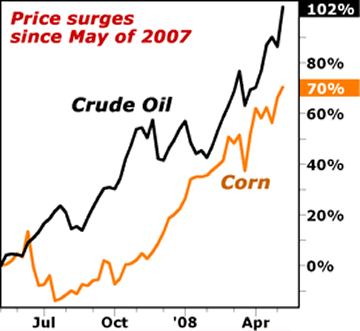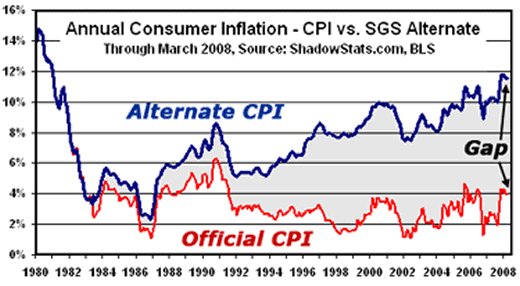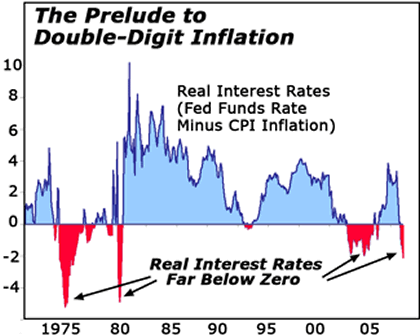US Heading for Double-Digit Inflation
Economics / Stagflation May 13, 2008 - 01:23 AM GMT Martin Weiss writes: Nearly all the pieces are now in place for inflation to strike with increasing speed and fury, catching Wall Street by surprise, throwing government policy into turmoil and, at the same time, opening up broad opportunities for investors.
Martin Weiss writes: Nearly all the pieces are now in place for inflation to strike with increasing speed and fury, catching Wall Street by surprise, throwing government policy into turmoil and, at the same time, opening up broad opportunities for investors.
I know. I've seen this movie once before. And the script will forever be ingrained in my mind.
It was 1978. Jimmy Carter was president. Oil prices had been surging for nearly seven years.
Other commodities — including silver, gold and food — were following closely behind.
Wholesale prices, import prices and the price of critical resources were climbing swiftly.
Most important, the Fed's pipe-smoking Chairman Arthur Burns, fearing a chain reaction of financial failures, pumped up the money supply with wild abandon, slashed interest rates — and set the stage for the worst U.S. inflation since the Civil War.
I saw it all, but I didn't believe it. I assumed Burns would come to his senses, see the obvious danger of inflation and reverse course.
But I assumed wrong.
Burns plowed ahead regardless of all the signs. He gave lip service to fighting inflation, while continuing to print money. And sure enough, about a year and half after he left the Fed, consumer price inflation was roaring at double-digit rates.

Today, 30 years have gone by.
Instead of Burns, we have Bernanke; instead of Carter, we have Bush.
And while I marvel at how much the world has changed, it never ceases to amaze me how little the Fed has learned.
Like the Burns Fed of the 1970s, the Bernanke Fed is trying to avert a chain reaction of failures. Like the decision-makers under Burns, the team under Bernanke is talking the talk of moderation, while walking the walk of inflation.
Can't they add up the numbers? Don't they see the handwriting on the wall? Maybe, maybe not. But all that matters is their actions — and the consequences of their actions ...
Already, U.S. producer prices have risen by almost 7% over the past year. And right now, they're surging at an annualized pace of 13.2%.
Already, U.S. import prices have catapulted 14.8% compared to a year earlier. And in the most recent month alone, they rose at an annualized rate of 33.6%!

And already, critical energy and food prices are rising at a pace that makes some of the 1970s surges seem small by comparison:
Just in the past 12 months, for example, corn is up 70%, sugar is up 72%, and the all-important price of crude oil is up by an astounding 102%.
In sum, with all of these prices jumping and with inflation clearly invading the daily life of average Americans ...
It Would Be the Epitome of Complacency to Assume Double-Digit Inflation Is Not in the Cards
Indeed, by many of the measures I've just cited — producer prices, import prices and commodity prices — we already have double-digit inflation in the U.S. today.
So isn't it suspicious that the only measure that does not yet reflect surging inflation — the Consumer Price Index — also happens to be the yardstick with the most immediate political implications?
Isn't it a bit worrisome when all measures of inflation are flying higher except the one that means the most for millions of Americans?
Until now, the discrepancy between actual inflation and the government's Consumer Price Index (CPI) was largely an academic debate few people paid much attention to.
Now, however, with real-world consumer prices jumping right before our eyes ... while the government's distorted CPI still lingers near the 4% area, the gap between the two is about to burst onto the scene as a scandalous cover-up.
According to John Williams' Shadow Statistics , the premier source of unadulterated U.S. economic indicators ...
- While the March year-over-year change in the official CPI was only 3.98% ...
- The true CPI, based on the same standards as those that prevailed before the Clinton administration, is now 11.58%!

This means that the gap between the official CPI and the alternate CPI is now a whopping 7.6 percentage points.
In other words, the U.S. government could now be understating the CPI by a full 7.6%!
Moreover, over the years, this gap has widened dramatically. Until January 1982, there was no gap whatsoever; and until November 1986, the gap was usually less than 1%. But then, it started widening like mad, and has been getting bigger ever since. Ironically ...
Despite the Shenanigans in The CPI, the Government Still Can't Keep the Number Down!
Even at just 4%, the official CPI inflation has clearly exceeded the Fed's target range. And even at this artificially low level, it is already triggering a gusher of concern.
In a Thursday posting to his blog, " Officials Ratcheting up Their Inflation-Fighting Rhetoric ," Mike Larson showed you just a few examples:
- Kansas City Fed President Thomas Hoenig: We are now facing "inflation psychology to an extent that I have not seen since the 1970s and early 1980s."
- IMF Deputy Chief John Lipsky: "This inflation speed-up must be taken seriously as it creates potentially significant challenges to economic stability." A return to 1970s-style high inflation and rising price expectations "cannot be discarded out of hand."
- ECB president Jean-Claude Trichet: "There's no time for complacency in any respect" as far as inflation expectations are concerned.
But talk is cheap. At the Fed — and in many countries — the only action that's under consideration is no action. In other words, keeping interest rates at their current low levels.
And with inflation surging, the only way they can keep interest rates down is by stepping up the flood of freshly printed money into the economy.
To Better Understand What's Really Happening, Here's What to Watch ...
Set aside, for the moment, all the debate about the CPI.
Bypass, for now, the various notions of how much money the government is pumping into the economy.
And above all, take with a grain of salt the official rhetoric that they're "fighting inflation."
All that is just talk. What counts is action. And the one single measure that best distills the true action is the level of real interest rates (interest rates minus inflation).
Example:
Interest rate: 5%
Inflation rate: 4%
Real interest rate = 1%
Real interest rates tell you if the Fed is just BS-ing or actually acting.
Real interest rates help give you a solid preview of whether inflation is likely to accelerate or not.
And real interest rates will be your best warning of a possible end to the inflationary cycle, when and if that time comes.
The reason: Real interest rates represent the true price of the most important "commodity" of all: Money.
Here's the scoop in a nutshell ...
- When real interest rates are high, money is expensive. If it persists, the days of inflation are numbered.
- When real interest rates are low, money is cheap. And with cheap money chasing scarce goods, inflation is bound to continue.
- Worse, when real interest rates are zero , money is not just cheap, it's effectively free. And free money chasing scarce goods puts inflation into overdrive.
- Worst of all, when real interest rates are below zero , money is not just free — but borrowers are, in effect, actually getting paid to take the money. And it's the abundance of this kind of highest-octave money that is the ultimate prelude to double-digit inflation.
That's what we have today: The Fed has dropped the fed funds rate to 2%. But the CPI inflation, even with all its distortions, is now close to 4%. So the real interest rate is ...
2% minus 4% = 2% below zero!
With this upside-down state of affairs, it matters little what the Fed says. Fed Chairman Bernanke could go before Congress. He could get down on his hands and knees. He could swear until he's blue in the face that he will "fight inflation." But until and unless the level of real interest rates rises back above zero — and beyond — nothing Bernanke says will make much of a difference.
Oil and commodity prices will continue to surge. Import prices will continue to jump. The dollar will continue to lose value. And inflation will continue to spiral upward.
This is precisely what happened in the mid-1970s under Burns:
He pushed short-term rates down dramatically.
He ignored the fact that consumer prices were rising at a faster clip.

And as a result, real interest rates plunged to zero ... 2% below zero ... 4% below zero ... ultimately as low as 5.2% below zero in February 1975 (red areas to the left side of chart).
And above all else, it was this super-money (borrowers virtually getting paid 5% to borrow it) that was the prelude to double-digit inflation in the late 1970s.
Now, here we are again — in the same place and with the same danger! Here we go again with real interest rates far below zero (red areas to the right side of chart)!
Does it matter that real interest rates today aren't quite as low as they were 30 years ago? No. What's more important is the fact that they've been kept at these low levels for so long.
And remember: The true inflation rate, stripped of the government's cover-ups and shenanigans, could be as much as seven full percentage points higher. That means that the red areas in the chart today could actually be much deeper in the danger zone than prevailed under Burns.
Bottom line: Brace yourself. Double-digit inflation is on the way.
What to Do Next
Step 1. If you haven't done so already, buy inflation hedges. Back in the 1970s, it was often cumbersome and inconvenient. Investors scrambled to buy gold bullion bars. Or they hoarded bags of silver coins. And when inflation eventually reversed itself, many got stuck with essentially illiquid investments.
Today, the instruments available are far more liquid. You can simply buy exchange-traded funds (ETFs) that own (or track) the inflation hedges of your choice, such as StreetTRACKS Gold Trust (GLD) or iShares Silver Trust (SLV).
Step 2. Also consider energy-related investments. Oil, natural gas and alternative energy sources are in the vanguard of this round of inflation, with no end in sight. Stocks and ETFs tied to their rise are bound to continue to benefit.
Step 3. Diversify out of the U.S. dollar by buying the strongest foreign currencies. Although the dollar could enjoy a nice rally in the near term, the long-term outlook remains negative. Even if the Fed pauses its recent rate-cutting ... even in the Fed actually raises rates ... as long as real interest rates in the U.S. remain below zero, it's unlikely to provide lasting support for the dollar.
Good luck and God bless!
Martin
This investment news is brought to you by Money and Markets . Money and Markets is a free daily investment newsletter from Martin D. Weiss and Weiss Research analysts offering the latest investing news and financial insights for the stock market, including tips and advice on investing in gold, energy and oil. Dr. Weiss is a leader in the fields of investing, interest rates, financial safety and economic forecasting. To view archives or subscribe, visit http://www.moneyandmarkets.com .
Money and Markets Archive |
© 2005-2022 http://www.MarketOracle.co.uk - The Market Oracle is a FREE Daily Financial Markets Analysis & Forecasting online publication.



